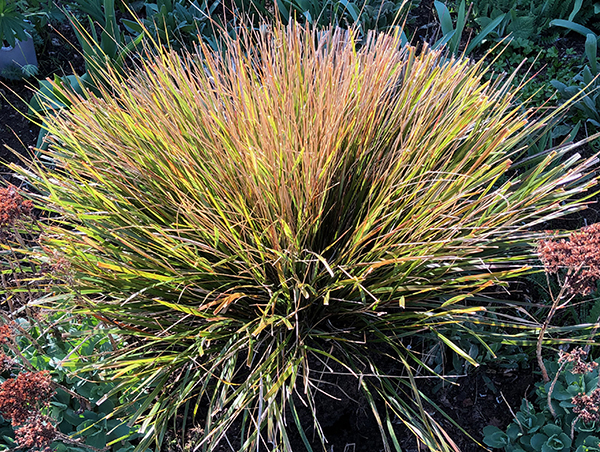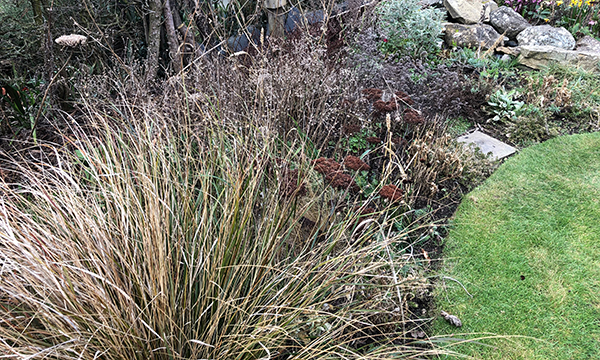I don’t have many grasses in my garden, but a couple of years ago I acquired a small pot of, what I call, pheasant grass (Anemanthele lessoniana, syn. Stipa arundinacea), which had seeded itself in a friend’s garden. Its most common names are pheasant’s-tail grass and New Zealand wind grass. It’s a lovely ornamental grass that provides a spray of year-round colour in various hues of copper, bronze, russet and gold. It starts off as quite a loose arching spray, but (as I found out!) can form a dense clump as it matures.

Everything I read said that it was an ideal grass for adding colour, movement and structure to a border and that it would self-seed itself (as it had done in my friend’s garden), so I popped it in my newly enlarged herbaceous border that runs down the side of the garden.
All was well for a while. Pheasant grass will thrive in any well-drained soil, in a sheltered or exposed spot. It prefers plenty of light but will do okay in partial shade as well. It was certainly happy in my sunny clay-based border, so much so that by the end of last year, 3 years after planting it, it had outgrown its welcome, swamping everything else around it.

Pruning evergreen ornamental grasses
My first plan was to try tidying it up. As a grass-growing newbie, I read up on it and found that, unlike the pruning of deciduous ornamental grasses, you should never cut an evergreen ornamental grass down to the ground, as it is unlikely to recover. You need to be a bit more selective and pull out the dead stuff.
In the utopian world of expert gardeners, you can ‘run your fingers through the grass and pull out the dead bits’. I tried this briefly and nearly lost my fingertips. Ouch! Apparently, only do this with young grasses that have been well maintained with a light pruning every Spring. If you’re not sure, wear gloves, as some grasses can be razor sharp! I have the scars to prove it.
The individual strands of my congested clump of pheasant grass were thick and tough, and they didn’t come away from the base of the plant when pulled. Instead, I had to selectively prune as many of the dead strands out as I could by cutting them individually from the base with secateurs. Not easy!
I then gave the whole clump a light trim to put some shape back into it (see top photo).
Dividing evergreen ornamental grasses
It was still too big for the border, so I decided to lift and divide it. It took a fair bit of digging out, and I certainly couldn’t ‘tease it apart with back-to-back forks’, as advised by the experts. Brute force, a sharp-edged spade and a lot of swearing worked though, and I eventually managed to split it into four much more manageable clumps.

A new home
I decided a prairie-style border wasn’t for me (I’m more of a cottage garden kind of girl), so I have made room for a much more manageable lupin (which the slugs will probably eat), and rehomed the new clumps of pheasant grass at the back of a border in the front garden. It will be interesting to see how they fair. I fear it might be too late, as the grass has become very congested, but I’m giving it a chance.

Lessons learned
I now know that you need to do a little light pruning of perennial evergreen grasses every Spring, pulling out the dead strands. If they self-seed, you can replace older plants with the seedlings. Tougher clumps (like mine) can be sawn apart if necessary. In theory, division should reinvigorate the plant. We’ll see!

thank-you so much for this. I too am fed up with the ‘tease out the dead bits’ completely useless guidance. I’ve given up a bit and am now resolved to only plant deciduous grasses that you can chop to the ground each year.
I hear you!!